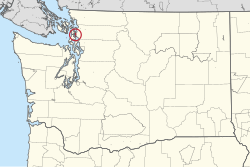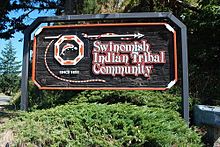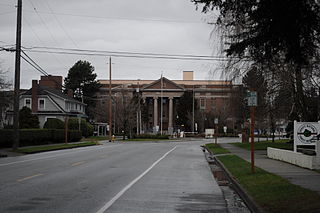
Skagit County is a county in the U.S. state of Washington. As of the 2020 census, the population was 129,523. The county seat and largest city is Mount Vernon. The county was formed in 1883 from Whatcom County and is named for the Skagit Indian tribe, which has been indigenous to the area prior to European-American settlement.

La Conner is a town in Skagit County, Washington, United States with a population of 965 at the 2020 census. It is included in the Mount Vernon–Anacortes, Washington Metropolitan Statistical Area. The town hosts several events as part of the annual Skagit Valley Tulip Festival held in April.

The Tulalip Tribes of Washington, formerly known as the Tulalip Tribes of the Tulalip Reservation, is a federally recognized tribe of Duwamish, Snohomish, Snoqualmie, Skagit, Suiattle, Samish, and Stillaguamish people. They are South and Central Coast Salish peoples of indigenous peoples of the Pacific Northwest Coast. Their tribes are located in the mid-Puget Sound region of Washington.

The Duwamish are a Lushootseed-speaking Southern Coast Salish people in western Washington, and the Indigenous people of metropolitan Seattle.

The Sauk-SuiattleIndian Tribe is a federally-recognized tribe of Sauk people located in western Washington state. The tribe historically lived along the banks of the Sauk, Suiattle, Cascade, Stillaguamish, and Skagit rivers, in the area known as Sauk Prairie at the foot of Whitehorse Mountain in the North Cascade Range.

The LummiNation is a federally-recognized tribe of primarily Lummi people. The Lummi Nation also includes some Nooksack, Samish, and other local tribes which were removed to the reservation. It is based in the coastal area of the Pacific Northwest region of Washington state in the United States, and is located within the Bellingham Metropolitan Area

The Swinomishpeople are a Lushootseed-speaking people Indigenous to western Washington state.
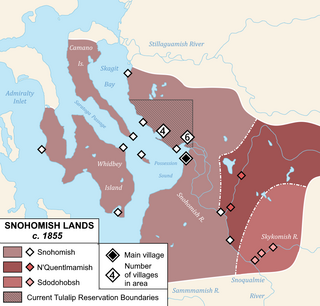
The Snohomish people are a Lushootseed-speaking Southern Coast Salish people who are indigenous to the Puget Sound region of Washington State. Most Snohomish are enrolled in the Tulalip Tribes of Washington and reside on the reservation or nearby, although others are enrolled in other tribes, and some are members of the non-recognized Snohomish Tribe of Indians. Traditionally, the Snohomish occupied a wide area of land, including the Snohomish River, parts of Whidbey and Camano Islands, and the nearby coastline of Skagit Bay and Puget Sound. They had at least 25 permanent villages throughout their lands, but in 1855, signed the Treaty of Point Elliott and were relocated to the Tulalip Reservation. Although some moved to the reservation, the harsh conditions, lack of land, and oppressive policies of the United States government caused many to leave.
The Samish are a Native American people who live in the U.S. state of Washington. They are a Central Coast Salish people. Through the years, they were assigned to reservations dominated by other Tribes, for instance, the Swinomish Indians of the Swinomish Reservation of Washington and the Tulalip Tribes of the Tulalip Reservation. They are also enrolled in the Samish Indian Nation, formerly known as the Samish Indian Tribe, which regained federal recognition in 1996.
The Sammamish people are a Lushootseed-speaking Southern Coast Salish people. They are indigenous to the Sammamish River Valley in central King County, Washington. The Sammamish speak Lushootseed, a Coast Salish language which was historically spoken across most of Puget Sound, although its usage today is mostly reserved for cultural and ceremonial practices.
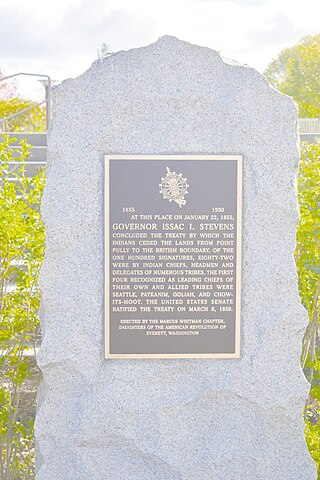
The Treaty of Point Elliott of 1855, or the Point Elliott Treaty,—also known as the Treaty of Point Elliot / Point Elliot Treaty—is the lands settlement treaty between the United States government and the Native American tribes of the greater Puget Sound region in the recently formed Washington Territory, one of about thirteen treaties between the U.S. and Native Nations in what is now Washington. The treaty was signed on January 22, 1855, at Muckl-te-oh or Point Elliott, now Mukilteo, Washington, and ratified 8 March and 11 April 1859. Between the signing of the treaty and the ratification, fighting continued throughout the region. Lands were being occupied by European-Americans since settlement in what became Washington Territory began in earnest from about 1845.
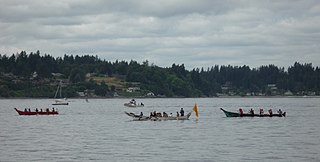
The Intertribal Canoe Journey is a celebrated event of the Indigenous peoples of the Pacific Northwest Coast. Organizers call it the Canoe Journey or Intertribal Canoe Journey, and colloqually Tribal Journeys. It is also referred to by its destination, i.e. Paddle to Muckleshoot.
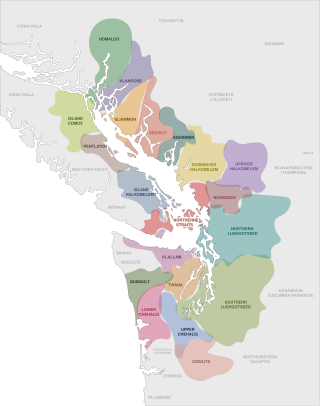
The Coast Salish are a group of ethnically and linguistically related Indigenous peoples of the Pacific Northwest Coast, living in the Canadian province of British Columbia and the U.S. states of Washington and Oregon. They speak one of the Coast Salish languages. The Nuxalk nation are usually included in the group, although their language is more closely related to Interior Salish languages.
The Lower Skagit are a tribe of the Lushootseed Native American people living in the U.S. state of Washington. Today they are enrolled in the federally recognized tribe, the Swinomish Indians of the Swinomish Reservation.

The Samish Indian Nation is a Coast Salish nation and a signatory to the Treaty of Point Elliott of 1855. Samish has a government-to-government relationship with the United States of America. The Samish are a Northern Straits branch of Central Coast Salish peoples. The Samish Nation is headquartered in Anacortes, Fidalgo Island, in Washington, north of Puget Sound.

The Swinomish Indian Reservation is the reservation of the Swinomish Indian Tribal Community, located on Fidalgo Island in western Washington state. The western boundary of the reservation is disputed between the Swinomish Tribe and the United States government. De facto, the reservation is around 15 square miles in size. It comprises a substantial portion of the eastern portion of Fidalgo Island. The total reservation population in 2000 was 2,664.
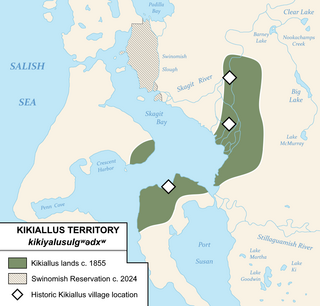
The Kikiallus people are a Lushootseed-speaking Coast Salish people Indigenous to parts of western Washington.
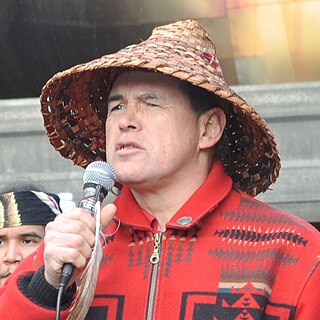
Brian Cladoosby is a Native American leader and activist. He served as chairman of the Swinomish Indian Tribal Community from 1997 to 2020 and was elected to his first of two terms as president of the National Congress of American Indians in October 2013. He previously served as president of the Affiliated Tribes of Northwest Indians.

The Lummi are a Central Coast Salish people Indigenous to western Washington, namely parts of the San Juan Islands and the mainland near what is now Bellingham, Washington.
